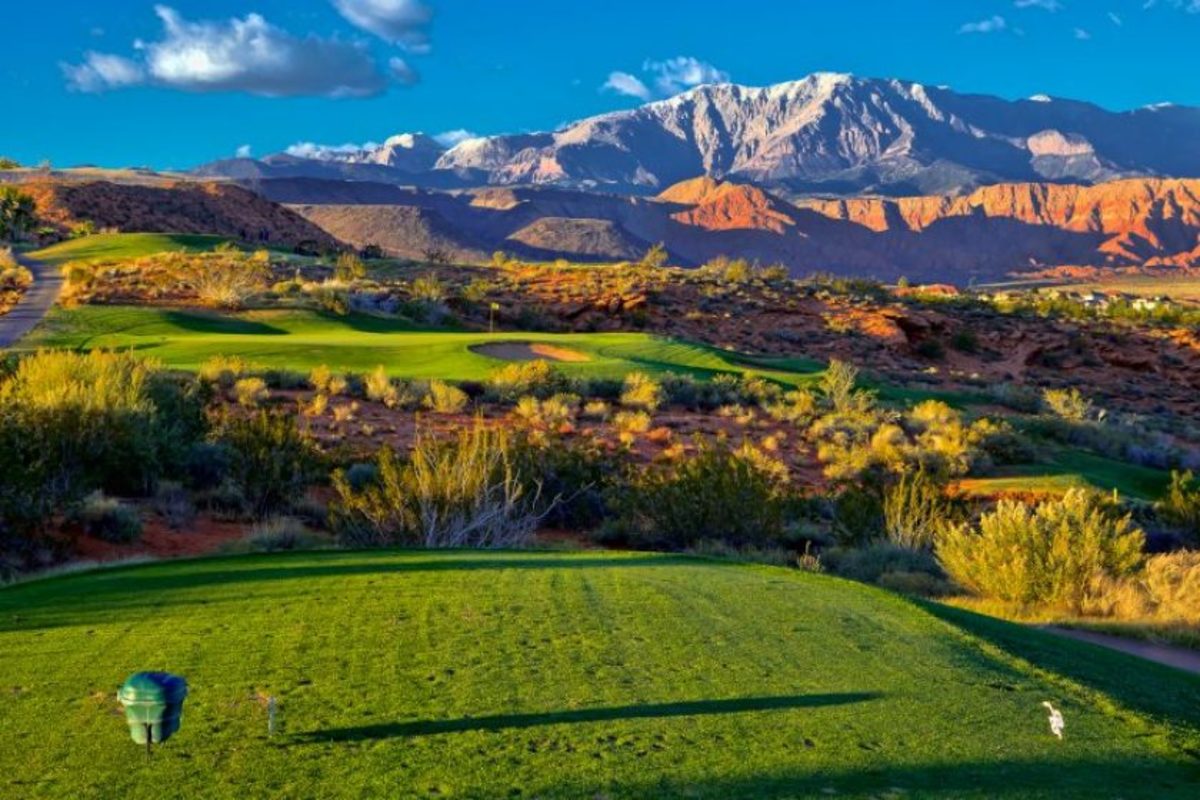Southern Utah: Greater Zion’s otherworldly golf vibe

This is how playing golf on Mars might feel, I thought. The terrain is so stark, so extreme, so … alien.
I had played golf in southern Utah once before, but the landscape I found this time took me back to the science fiction I’d devoured as a kid. Isaac Asimov’s The Martian Chronicles popped into my head for the simple fact that the rock formations all around me were so damn red.
Southern Utah — long a mecca for hikers and backpackers drawn to the other-worldly landscape of its five national parks — has quietly morphed into a first-rate golf destination. Over the years, the canyons, ridges and plateaus served as canvases for the likes of golf course architects John Fought, Andy Staples, Johnny Miller, Ted Robinson and Matt Dye.
The Washington County towns of St. George, Hurricane and Washington City form Utah’s golf epicenter. St. George, the largest town, is about two hours up Interstate 15 from Las Vegas.
The area’s menu of 13 golf courses boasts six of Golfweek’s 2019 Top 10 You Can Play in Utah: 1, Sand Hollow Resort (Championship Course); 3, Entrada at Snow Canyon; 6, Sunbrook Golf Club (Pointe/Woodbridge); 7, Green Spring Golf Course; 9, Coral Canyon Golf Club; and 10, The Ledges Golf Course.
A new course, Copper Rock Golf Club, near Hurricane, opens this month.
Word about the quality of the area’s golf is getting out. In 2018, 217,000 out-of-town golfers visited southern Utah, also known as Greater Zion, 45 percent more visitors than those who came in pursuit of other sports and outdoor adventure.

They play golf year-round, thanks to 300-plus days of sunshine and mild, relatively dry winters. Daily highs in December and January reach the 50s, but the sweet spots for golf are March through May and September through November, when a sweater is about the heaviest outerwear necessary.
Rates at Greater Zion’s courses range from just $50 for a weekend round with cart at Washington City’s municipal course, Green Spring, to $145 for a weekend round with cart at Sand Hollow.
On the drive from St. George to the Sand Hollow Resort, near Hurricane, I spotted a pale green fairway in the distance that at first glance seemed suspended in mid-air above the red-rock horizon. The next day, when I stood on that fairway, No. 12 of the Championship Course, I had a sweeping 360-degree view of desert and snow-capped mountains for 60 miles. On the tee of the par-3 15th hole, jagged red sandstone crags rose out of the ground between me and the green. And just like that, I was back on Asimov’s Mars.
Sand Hollow was co-designed by Fought and Staples. To take advantage of the promontory atop the plateau that created my mirage of a fairway floating in the sky, the two men engaged in Staples’ self-described “maximalist” style and removed 26,000 cubic yards of rock and dirt — “about 99 percent of that” from just five holes of the back nine, Staples told interviewer Jason Way of TheFriedEgg.com last year.
The result is one of the most dramatic back nines you’ll find anywhere in golf. The fifth and sixth holes of Quivira Golf Club in Los Cabos, Mexico, spring to mind – golf holes hanging from, clinging to, the edge of a sheer cliff.

At the top of the market, Sand Hollow is clearly the star of Greater Zion golf. Running a close second for topographic visuals is The Ledges. Winner of my value golf award is Green Spring.
While much of Utah may seem far from civilization, this corner of the state is not. St. George Regional Airport (SGU) is served by multiple daily non-stops to and from Dallas, Phoenix, Salt Lake City, and Los Angeles. By car, Los Angeles is just six hours away – a proximity that helped make St. George one of the fastest-growing towns in the United States a few years ago.
Recently, visitation to the area’s national parks – Zion, Bryce, Canyonlands, Capitol Reef and Arches – has gone through the roof, thanks to a successful (some argue too successful) marketing campaign that started in 2013.
Visitation to the five parks jumped 12 percent in 2014, 14 percent in 2015, and 20 percent in 2016 – skyrocketing from 6.3 million to over 10 million in just three years, author Mark Sundeen wrote in a piece for OutsideOnline.com in January.
That surge led to a still-ongoing boom in construction of lodging. Choices run the gamut from national-brand hotels to no-name budget motels to quaint western-themed B&Bs. Near Zion, a glamping family can rent a six-person canvas tent pitched atop a wooden floor and equipped with a wood-burning stove and ensuite bathroom – digs comparable to those you would find on a high-end Southern Africa safari.
And it’s not just the granola crowd flocking to Greater Zion. The area features dozens of desert ATV rental shops and endless desert for gearheads to do dusty doughnuts. You’ll also find mountain biking, rock climbing and horseback riding. They even scuba-dive in Sand Hollow State Park’s lake.
For me, though, it’s the courses of Greater Zion that hold a special appeal. Because neither I nor even Elon Musk will be going to Mars any time soon, southern Utah is about as close as we’ll get.
